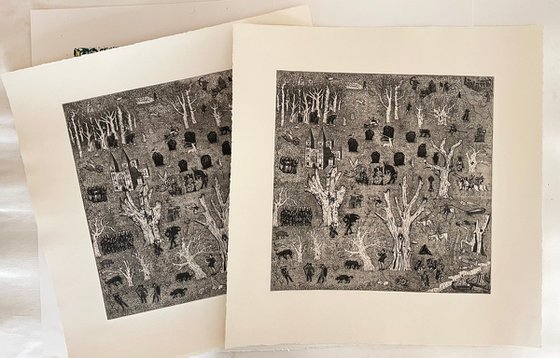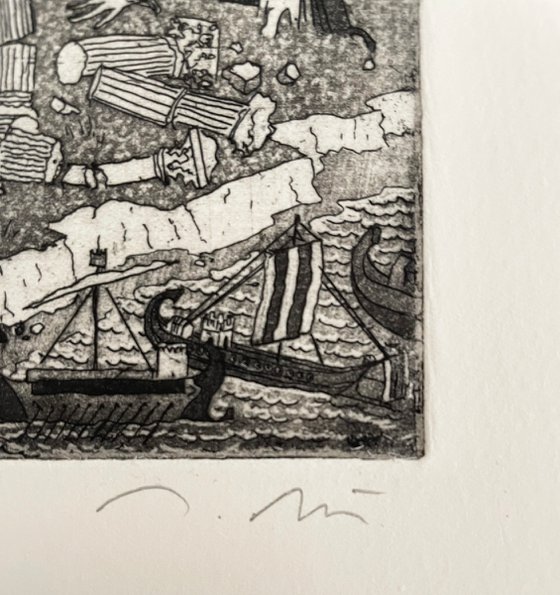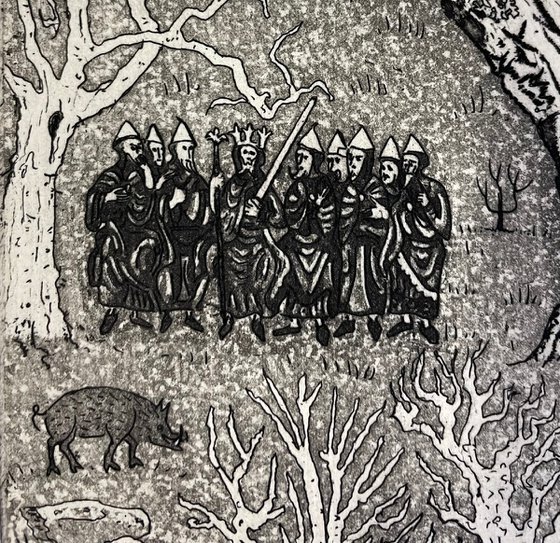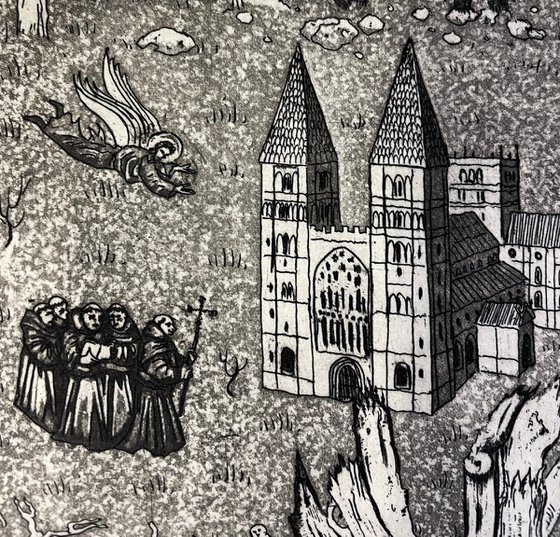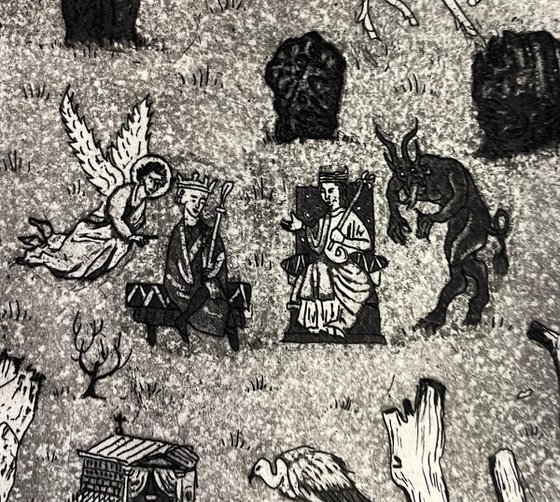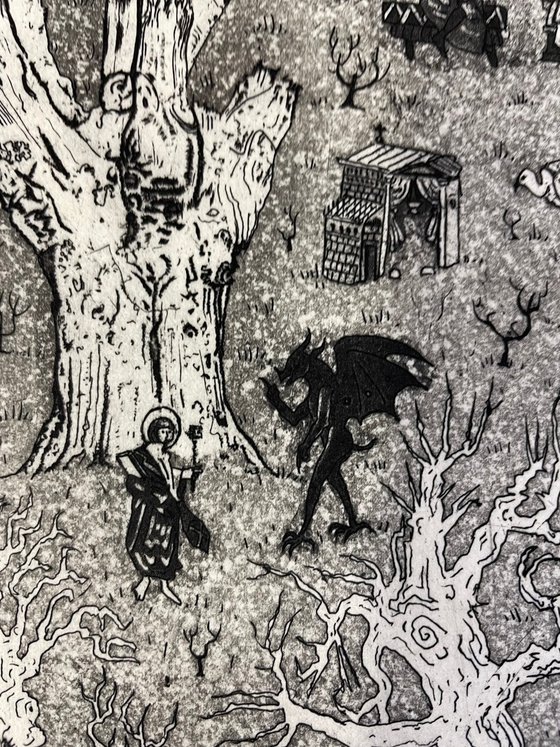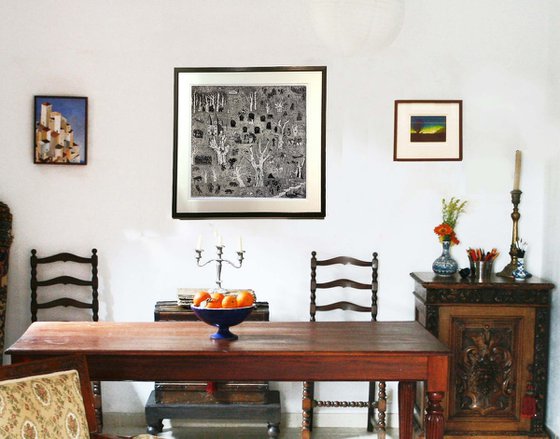Artwork description:
This etching is part of a history series of etchings.
My interpretation of the Dark Ages explores the period between the fall of the Roman Empire in 454 and the death of Harold Godwinson in 1066. I use actual events, stories and figures of the period intertwined with themes of ‘dark’ and ‘light’, good and evil in terms of beliefs and mysticism which preoccupied people during these times. To quote Petrarch in 1330 - "Amidst the errors there shone forth men of genius; no less keen were their eyes, although they were surrounded by darkness and dense gloom”. Petrarch uses the metaphors of 'light versus darkness' to describe 'good versus evil'.
The story starts with the fall of Rome - bottom right of image. The fabric of society collapses and Romans flee to waiting triemes. Sweeping in behind the fleeing Romans are three of the four horsemen of the apocalypse. The latter of the horseman is dragging a corpse in a coffin while another two coffins await removal. It is left to speculate as to the whereabouts of the fourth horseman. Fallen from its place of hanging, smashed and broken on the ground and preceding the horsemen, is the death knell. Looming over the scene is a dying tree in the last gasps of life.
Moving upwards in the image, a triumphant King Offa and his men head west to their Welsh homelands. Watching on are two pagans. The top right of the image is Northumberland, with Viking raiders approaching in boats. On Holy Island St Cuthbert warns of the impending danger posed by the Vikings. Below, The Venerable Bede looks more vulnerable than venerable as a viking raider charges towards him with a heft spear.
Central and top in scene of respite and tranquility, a man ploughs a field, a hare leaps playfully and a shepherd guides a flock of sheep around foreboding dark woods. Through the dark woods move the Lewis chessmen. Like all the creatures in the image, they are caught in an existential game of survival until they are checkmated and the game is over. The board is then cleared and a new game can start in a never ending cycle of struggles for survival.
Dominating the Northern section of the image is the stone circle of Bera Way. Although there are seven stones in the image, two have been lost to time, although the holes where they stood remain. I have included these in the image as reference to earlier histories and how these still resonate today as mystical and special places. Within the stone circle, in the most scared of places, is a resplendent White Stag. This majestic beast symbolises the power of good. He is feted by a wise owl and a hare playing a harp.
At the very centre of the image is Alfred the Great and his Queen Æthelflæd. Although they are representative of all Saxon monarchs, Alfred is the king who unites the seven kingdoms of England, therefore shaping the destiny of the kingdom. Here the king is receiving counsel from an angel while queen is beguiled by a demon.
A magnificent Romanesque minster is blessed by an angel as a group of monks process towards the place of worship. Below the King meets with the Wittan overseen by an owl representing the wisdom of parliament. To their right good battles evil in the form of a demon and an angel, while below the final scenes sees the murder of King Harold by a Norman bowman. The murderers fates also looks uncertain as a number of wolves circle furiously around them, thus concluding the end of the Dark Ages!
One further note is about the white trees. I have chosen to depict all the trees in white. This is in part to symbolise the collapse of society in the dark ages, and in part to show light and goodness.
Tags:
#dark #etching #limited edition print #history #light and dark #stone circle #roman empire #circle of life #good and evil #horsemen of the apocalypse #dark ages #olden times #anglo saxonsDark Ages (2024)
Etching / Engraving
by Tim Southall
15 Artist Reviews
£250
- Etching / Engraving on Paper
- From a limited edition of 75
- Size: 42 x 42 x 0.1cm (unframed) / 30 x 30cm (actual image size)
- Signed and numbered on the front
- Style: Graphic
- Subject: People and portraits
Artwork description
This etching is part of a history series of etchings.
My interpretation of the Dark Ages explores the period between the fall of the Roman Empire in 454 and the death of Harold Godwinson in 1066. I use actual events, stories and figures of the period intertwined with themes of ‘dark’ and ‘light’, good and evil in terms of beliefs and mysticism which preoccupied people during these times. To quote Petrarch in 1330 - "Amidst the errors there shone forth men of genius; no less keen were their eyes, although they were surrounded by darkness and dense gloom”. Petrarch uses the metaphors of 'light versus darkness' to describe 'good versus evil'.
The story starts with the fall of Rome - bottom right of image. The fabric of society collapses and Romans flee to waiting triemes. Sweeping in behind the fleeing Romans are three of the four horsemen of the apocalypse. The latter of the horseman is dragging a corpse in a coffin while another two coffins await removal. It is left to speculate as to the whereabouts of the fourth horseman. Fallen from its place of hanging, smashed and broken on the ground and preceding the horsemen, is the death knell. Looming over the scene is a dying tree in the last gasps of life.
Moving upwards in the image, a triumphant King Offa and his men head west to their Welsh homelands. Watching on are two pagans. The top right of the image is Northumberland, with Viking raiders approaching in boats. On Holy Island St Cuthbert warns of the impending danger posed by the Vikings. Below, The Venerable Bede looks more vulnerable than venerable as a viking raider charges towards him with a heft spear.
Central and top in scene of respite and tranquility, a man ploughs a field, a hare leaps playfully and a shepherd guides a flock of sheep around foreboding dark woods. Through the dark woods move the Lewis chessmen. Like all the creatures in the image, they are caught in an existential game of survival until they are checkmated and the game is over. The board is then cleared and a new game can start in a never ending cycle of struggles for survival.
Dominating the Northern section of the image is the stone circle of Bera Way. Although there are seven stones in the image, two have been lost to time, although the holes where they stood remain. I have included these in the image as reference to earlier histories and how these still resonate today as mystical and special places. Within the stone circle, in the most scared of places, is a resplendent White Stag. This majestic beast symbolises the power of good. He is feted by a wise owl and a hare playing a harp.
At the very centre of the image is Alfred the Great and his Queen Æthelflæd. Although they are representative of all Saxon monarchs, Alfred is the king who unites the seven kingdoms of England, therefore shaping the destiny of the kingdom. Here the king is receiving counsel from an angel while queen is beguiled by a demon.
A magnificent Romanesque minster is blessed by an angel as a group of monks process towards the place of worship. Below the King meets with the Wittan overseen by an owl representing the wisdom of parliament. To their right good battles evil in the form of a demon and an angel, while below the final scenes sees the murder of King Harold by a Norman bowman. The murderers fates also looks uncertain as a number of wolves circle furiously around them, thus concluding the end of the Dark Ages!
One further note is about the white trees. I have chosen to depict all the trees in white. This is in part to symbolise the collapse of society in the dark ages, and in part to show light and goodness.
Tags:
#dark #etching #limited edition print #history #light and dark #stone circle #roman empire #circle of life #good and evil #horsemen of the apocalypse #dark ages #olden times #anglo saxonsReturns and refunds
We want you to love your art! If you are not completely satisfied with your purchase you can return it free within 14 days, no questions asked. Learn more
Artist Reviews (15)
This artwork is sold by Tim Southall from Spain

